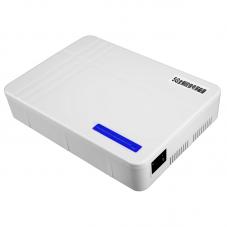In the fight to stop criminals from using contraband phones in prison, law enforcement may be a little closer to having technology that could interfere with phone signals in prison without affecting nearby communications.
In January, Justice Department officials and researchers from the National Telecommunications and Information Administration gathered in a federal prison to test technology that could interfere with the wireless service of the thousands of cell phones introduced into prisons each year.
NTIA released the results of the last winter test this month.
Using a prototype device from an unnamed vendor, NTIA said the test successfully blocked commercial cell phone signals in a cell at the Federal Correctional Institution in Cumberland, MD, but left commercial air waves unobstructed only 20 feet outside the facility's walls.
"These promising test results represent a step forward in addressing the security threat posed by smuggled cell phones," said Beth Williams, assistant attorney general in the Justice Department's Office of Legal Policy, in a June 15 statement.
The ability to interfere with prisoners' cell phones has become a major target for the DOJ and other federal agencies.
Cell phones smuggled into prisons are used for all kinds of mayhem, from controlling gang activity and violent crimes inside and outside the jail to distributing child pornography and intimidating witnesses, officials say.
The Federal Communications Commission passed rules in March last year to expedite the licensing of anti-smuggling systems in prisons. Since they use commercial spectrum, they need FCC licenses to operate. Such systems either detect transmissions or use a managed access approach developed from the licensed commercial spectrum that authenticates devices using them.
NTIA has to coordinate the technology with the FCC.
According to a study, NTIA researchers installed the cell phone jammer in January in a storage room next to a 13-by-8-foot cell on the first floor of the prison's residential unit. It successfully blocked cell phone transmissions in commercial bands between 700 and 2170 MHz, but did not interfere with commercial transmissions when monitored from 20 feet and 100 feet outside the cell, the study said.

However, according to NTIA, further study is needed to determine whether the technology could pose a potential threat to commercially licensed wireless services outside the prison walls.
A few hurdles remain. The agency found that the test results were unique to one location and that results would likely vary widely in other prison facilities.
To fully cover a prison would require a fleet of systems - up to 100 cell phone jamming systems - which, according to the NTIA study, could lead to significant power problems.
"The results suggest the possibility of a localized impact from this micro-jamming technology," said Williams. "This is an encouraging sign that brings us closer to a solution that will make our communities safer and help prevent criminal activity from continuing inside the prison walls."
The DOJ said the Bureau of Prisons will use the report to get a better strategic view of the evolving technology and conduct further testing.
